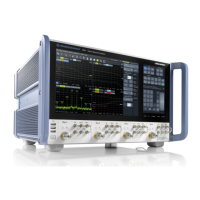Concepts and features
R&S
®
ZNA
271User Manual 1178.6462.02 ─ 20
4.7.17 Delta-L 4.0 PCB characterization
Option R&S ZNA-K231
Delta-L is a de-embedding methodology developed by Intel Corporation and is used for
de-embedding strip lines that include vias. Delta-L calculates the loss of PCB intercon-
nects and can be performed on single-ended or balanced interconnects.
The objective of Delta-L is to determine an insertion loss measurement defined on two
or more coupon lines of differing lengths. This ratio of insertion loss in dB/inch can be
applied to any trace length with similar vias.
For background information, see
●
https://www.intel.com/content/dam/www/public/us/en/documents/guides/delta-l-
plus-methodology-for-electrical-characterization-guide.pdf
●
https://ieeexplore.ieee.org/document/7048423
The R&S ZNA uses the Clear Signal Solutions AITT-DL implementation of the Delta-L
v4.0 algorithms (see https://clearsig.com/clearsig/tools/#Delta). It allows you to per-
form:
●
1L (one line/length) analysis
Typically used for high-volume manufacturing (relative comparison)
●
2L analysis
Typically used for board-quality validation (removes the test fixture impact)
●
3L analysis
Typically used for material characterization (best accuracy, self-validation of
results).
3L
2L
1L
Figure 4-35: Test coupons for 1L, 2L and 3L measurements
Option R&S ZNA-K231 can be ordered with a new instrument or retrofitted at
Rohde&Schwarz service.
Optional extensions and accessories

